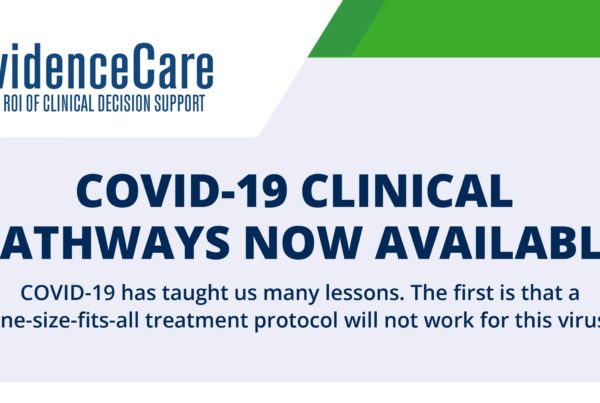This article was updated in December 2021 to reflect the latest CMS implementation dates.
The official CMS Appropriate Use Criteria page displays a notice that reads: “The EDUCATIONAL AND OPERATIONS TESTING PERIOD for the AUC Program has been extended beyond CY 2021. There are no payment consequences associated with the AUC program during the Educational and Operations Testing Period. We encourage stakeholders to use this period to learn, test and prepare for the AUC program.”
While there may not be payment consequences until 2023, hospitals shouldn’t wait until then to prepare for the AUC program.
In this article we’ll cover the background of the AUC program, when it will be fully implemented, and most importantly, how you can learn, test, and prepare for the AUC program.
We want to help you make sure a mandate doesn’t get in the way of delivering great patient care and your hospital getting reimbursed.
What is the AUC Program?
In 2014, a section of the Protecting Access to Medicare Act (PAMA) established a new program to reduce inappropriate or unnecessary advanced diagnostic imaging services such as CT and PET scans and MRIs. This program is called the Appropriate Use Criteria (AUC) Program, but you’ll also see it written as AUC Mandate, CMS AUC Mandate, PAMA Mandate, and more.
No matter what it’s called, its goal is to ensure clinicians who order outpatient advanced imaging services for Medicare members have medical necessity to do so.
How is medical necessity determined under this program?
CMS determined the ordering clinician must consult a qualified Clinical Decision Support Mechanism (qCDSM) which determines appropriate use of imaging services. A CDSM is an interactive, electronic tool that communicates AUC through a module, portal, or software to assist clinicians in making the best treatment decision for a patient’s specific clinical condition. The ‘q’ for ‘qualified’ is simply a list of CMS-approved CDSMs who went through an application process to qualify for appropriate use.
The companies who created a qCDSM get their clinical guidance from qualified Provider Led Entities (PLEs) which consist of medical specialty societies or organizations that write evidence-based guidelines. A few examples include Intermountain Healthcare, American College of Radiology, Johns Hopkins University School of Medicine, and Medical Guidelines Institute.
When submitting a claim under this program, it must include 1) the ordering clinician’s National Provider Identifier (NPI), 2) which qCDSM was used, and 3) a series of modifiers to designate if the imaging order adheres to the consulted AUC.
Multiple research studies have shown the positive impact of clinical decision support (CDS) tools, and this study at Aurora Health Care showed that CDS reduced targeted imaging orders by a statistically significant 6%.
When is the AUC Program fully implemented?
Many doctors feel frustrated by another mandate that tells them how to deliver care, but the reality is that the AUC Program is unlikely to go away. The Medicare Payment Advisory Committee (MEDPAC) continues to cite overutilization of imaging services as a major concern, which is a main driver for implementing prior authorization programs.
While there have been delays in fully implementing the AUC Program, the assumption in 2021 was that financial impact on hospitals would start in January 2022. In July 2021, however, the proposed rule for the physician fee schedule from the federal register requested waiting until 2023 to continue editing their claims processing system.The American Hospital Association commented in favor of delaying the mandate which is a strong indicator of where the decision might lead.
In November 2021, it was announced that the mandate would be delayed until January 1, 2023 or the January 1 following the declared end of the COVID-19 public health emergency (PHE).
How to “learn, test, and prepare” for the AUC Program
Even though the mandate’s fee schedule is delayed, the overall shift to a value-based care model still makes preparation for this program important. 2022 is a great year for providers to “learn, test, and prepare,” and we put together a detailed checklist and guide hospitals can use to prepare.
Download EvidenceCare’s 5 Point Checklist for Hospitals to Prepare for the AUC Program provided by our VP of Clinical Rev Cycle Integration, Carol Howard.
CMS also provided some guidance for what preparation looks like. To start, hospital leaders need to implement a qCDSM and build the consultation into their processes. But not all CDSMs are created equal – more on that in the last section.
Once a qCDSM consultation process is implemented, hospitals will be required to report the AUC/CDS information. CMS encouraged providers to submit claims with a Current Procedural Terminology (CPT) or HCPCS C code for advanced diagnostic imaging along with a line item HCPCS modifier to describe either the level of adherence to AUC or an exception to the program.
CMS provided eight modifiers to be reported on the same line as the CPT code for the imaging service. They even added a modifier (MH) for situations where an order doesn’t meet AUC.
- MA – Ordering professional is not required to consult a clinical decision support mechanism due to service being rendered to a patient with a suspected or confirmed emergency medical condition
- MB – Ordering professional is not required to consult a clinical decision support mechanism due to the significant hardship exception of insufficient internet access
- MC – Ordering professional is not required to consult a clinical decision support mechanism due to the significant hardship exception of electronic health record or clinical decision support mechanism vendor issues
- MD – Ordering professional is not required to consult a clinical decision support mechanism due to the significant hardship exception of extreme and uncontrollable circumstances
- ME – The order for this service adheres to the appropriate use criteria in the clinical decision support mechanism consulted by the ordering professional
- MF – The order for this service does not adhere to the appropriate use criteria in the qualified clinical decision support mechanism consulted by the ordering professional
- MG – The order for this service does not have appropriate use criteria in the clinical decision support mechanism consulted by the ordering professional
- MH – Unknown if ordering professional consulted a clinical decision support mechanism for this service, related information was not provided to the furnishing professional or provider
- QQ – Ordering professional consulted a qualified clinical decision support mechanism for this service and the related data was provided to the furnishing professional
Lastly, a separate line is provided for a “G-code” that identifies which qualified CDSM was consulted for the AUC. Each qCDSM has a corresponding G-Code – e.g. EvidenceCare’s ImagingCare is Code G1013.
Want a more in-depth, step-by-step checklist on how to prepare for the AUC Program?
Fill out the form to download our 5 point checklist for hospitals to prepare for the AUC program.
ImagingCare provides easy consultation of AUC
ImagingCare is EvidenceCare’s efficient and easy-to-use qCDSM designed by physicians for physicians. Unlike other qCDSMs, ImagingCare is embedded in the EHR workflow so clinicians don’t have to go to outside modules or portals to access the required criteria.
ImagingCare auto-populates in the EHR and allows clinicians to edit final order information to tie it to the AUC, and then ImagingCare will provide the required codes and documentation for accurate reporting.
We partner with Intermountain Healthcare as our PLE to implement their imaging criteria guidelines recognized as evidence-based care pathways framed with a population health management model. Intermountain Healthcare’s criteria is developed through 7 steps:
- Identification of Priority Clinical Areas as defined by CMS, and assignment to the most appropriate Clinical Program and development of a project plan.
- Constitution of a development team to build and maintain the AUC.
- Performance of an evidentiary review.
- Creation of AUC in the most appropriate format.
- Testing and validation.
- Publishing AUC to Intermountain’s Intermountain Imaging Criteria website.
- Review on an annual basis of published AUC.
We’d love to help you prepare for full implementation of the AUC Program. Let us know if you’d like to schedule a demo for ImagingCare.









